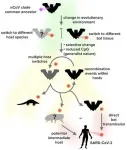Metabolic derangements caused by a high-fat diet may be possible to eliminate
2021-03-12
(Press-News.org) Intake of a high-fat diet leads to an increased risk for obesity, type 2 diabetes, cardiovascular diseases and fatty liver. A study in mice from Karolinska Institutet in Sweden shows that it is possible to eliminate the deleterious effects of a high-fat diet by lowering the levels of apolipoprotein CIII (apoCIII), a key regulator of lipid metabolism. The study is published in the journal Science Advances.
Increased levels of the protein apoCIII are related to cardiovascular diseases, insulin resistance and type 2 diabetes. Researchers at the Rolf Luft Research Center, Karolinska Institutet, have previously shown that apoCIII increases in the hormone secreting part of the pancreas, the islets of Langerhans, in parallel with the development of insulin resistance and diabetes.
The same researchers have now studied two groups of mice who were fed a high-fat diet from the age of 8 weeks, and a control group of mice on a normal diet. One of the groups on a high-fat diet received so-called antisense (ASO) treatment after 10 weeks on the diet to decrease apoCIII levels, and the other group had already been treated with ASO from the start thereby preventing an increase in apoCIII.
"After a period of 10 weeks, all of the mice in the first group were obese, insulin resistant and had liver steatosis. However, after ASO treatment, still being on the high-fat diet, there was a normalisation of glucose metabolism, weight and liver morphology," says Ismael Valladolid-Acebes, assistant professor at the Department of Molecular Medicine and Surgery, Karolinska Institutet, and first author of the study.
In the group that was treated with ASO directly from start, the development of metabolic derangements was prevented, and the animals had the same body composition and metabolism as the control mice on a normal diet. The mechanisms underlying the effects of the apoCIII-lowering treatment involve increased lipase enzyme activity and receptor-mediated uptake of lipids to the liver. Fatty acids were transferred by fatty acid oxidation to the biochemical process in the liver called the ketogenic pathway and then converted to ketones that were used for heat production in brown adipose tissue.
"Thus, we could demonstrate that a lowering of apoCIII levels, despite ongoing intake of a high-fat diet, not only protects against, but also reverses the deleterious fat-induced metabolic derangements by promoting an overall increased insulin sensitivity," says Lisa Juntti-Berggren, professor at the Department of Molecular Medicine and Surgery, Karolinska Institutet, and senior author of the study.
INFORMATION:
The research was supported by the Swedish Diabetes Association, Karolinska Institutet's Foundations and Funds, The Swedish Research Council, the Novo Nordisk Foundation, The Family Erling-Persson Foundation, the Strategic Research Program in Diabetes at Karolinska Institutet, The Knut and Alice Wallenberg Foundation, The Stichting af Jochnick Foundation, Skandia Insurance Company Ltd., the Diabetes and Wellness Foundation, The Bert von Kantzow Foundation, Svenska Diabetesstiftelsen, AstraZeneca, the Swedish Association for Diabetology and The European Research Council (ERC).
Co-author Per-Olof Berggren is co-founder and CEO of Biocrine, a biotech company that is focusing on apoCIII as a potential drug target in diabetes. Lisa Juntti-Berggren is a consultant for the same company and has participated in advisory boards for NovoNordisk, AstraZeneca and Sanofi.
Publication: "Lowering apolipoprotein CIII protects against high-fat diet-induced metabolic derangements". Ismael Valladolid-Acebes, Karin Åvall, Patricia Recio-López, Noah Moruzzi, Galyna Bryzgalova, Marie Björnholm, Anna Krook, Elena Fauste Alonso, Madelene Ericsson, Fredrik Landfors, Stefan K Nilsson, Per-Olof Berggren, Lisa Juntti-Berggren. Science Advances, online 12 March 2021, doi: 10.1126/sciadv.abc2931.
ELSE PRESS RELEASES FROM THIS DATE:
2021-03-12
New research led by the University of Cambridge has found rare evidence - preserved in the chemistry of ancient rocks from Greenland - which tells of a time when Earth was almost entirely molten.
The study, published in the journal Science Advances, yields information on a important period in our planet's formation, when a deep sea of incandescent magma stretched across Earth's surface and extended hundreds of kilometres into its interior.
It is the gradual cooling and crystallisation of this 'magma ocean' that set the chemistry of Earth's interior - a defining stage in the assembly of our planet's structure and the formation of our early atmosphere.
Scientists know that catastrophic impacts during the formation of the Earth and Moon would have generated ...
2021-03-12
As the driver of global atmospheric and ocean circulation, the tropics play a central role in understanding past and future climate change. Both global climate simulations and worldwide ocean temperature reconstructions indicate that the cooling in the tropics during the last cold period, which began about 115,000 years ago, was much weaker than in the temperate zone and the polar regions. The extent to which this general statement also applies to the tropical high mountains of Eastern Africa and elsewhere is, however, doubted on the basis of palaeoclimatic, geological and ecological studies at high elevations.
A research team led by Alexander Groos, Heinz Veit (both from the Institute of Geography) and Naki Akçar (Institute of Geological Sciences) at the University ...
2021-03-12
How much did SARS-CoV-2 need to change in order to adapt to its new human host? In a research article published in the open access journal PLOS Biology Oscar MacLean, Spyros Lytras at the University of Glasgow, and colleagues, show that since December 2019 and for the first 11 months of the SARS-CoV-2 pandemic there has been very little 'important' genetic change observed in the hundreds of thousands of sequenced virus genomes.
The study is a collaboration between researchers in the UK, US and Belgium. The lead authors Prof David L Robertson (at the MRC-University of Glasgow Centre for Virus Research, Scotland) ...
2021-03-12
Informing how COVID-19 response plans may incorporate digital contact tracing, a model of COVID-19 spread within a simulated French population found that if about 20% of the population adopted a contact tracing app on their smartphones, an outbreak could be reduced by about 35%. If more than 30% of the population adopted the app, the epidemic could be suppressed to manageable levels. Jesús Moreno López and colleagues note that the effectiveness of digital contact tracing would depend on a given population's level of immunity to the virus; the intervention alone would be unable to suppress a COVID-19 epidemic where transmission - and especially asymptomatic transmission - remains high. While many countries have implemented ...
2021-03-12
DURHAM, N.C. -- If you binged on high-calorie snacks and then spent the winter crashed on the couch in a months-long food coma, you'd likely wake up worse for wear. Unless you happen to be a fat-tailed dwarf lemur.
This squirrel-sized primate lives in the forests of Madagascar, where it spends up to seven months each year mostly motionless and chilling, using the minimum energy necessary to withstand the winter. While zonked, it lives off of fat stored in its tail.
Animals that hibernate in the wild rarely do so in zoos and sanctuaries, with their climate controls and ...
2021-03-12
Decades of feminist gains in the workforce have been undermined by the COVID-19 pandemic, which has upended public education across the United States, a critical infrastructure of care that parents -- especially mothers -- depend on to work, according to new research from Washington University in St. Louis.
The research, published in Gender & Society, draws on new data from the Elementary School Operating Status (ESOS) database to show that the gender gap between mothers and fathers in the labor force has grown significantly since the onset of the pandemic in states where schools primarily offered remote instruction.
And if these circumstances continue, it could deliver ...
2021-03-12
Sound sleep plays a critical role in healing traumatic brain injury, a new study of military veterans suggests.
The study, published in the Journal of Neurotrauma, used a new technique involving magnetic resonance imaging developed at Oregon Health & Science University. Researchers used MRI to evaluate the enlargement of perivascular spaces that surround blood vessels in the brain. Enlargement of these spaces occurs in aging and is associated with the development of dementia.
Among veterans in the study, those who slept poorly had more evidence of these enlarged spaces and more post-concussive symptoms.
"This has huge implications for the armed forces as well as civilians," said lead author Juan Piantino, M.D., MCR, assistant professor of pediatrics (neurology) in the ...
2021-03-12
Astronomers have painted their best picture yet of an RV Tauri variable, a rare type of stellar binary where two stars - one approaching the end of its life - orbit within a sprawling disk of dust. Their 130-year dataset spans the widest range of light yet collected for one of these systems, from radio to X-rays.
"There are only about 300 known RV Tauri variables in the Milky Way galaxy," said Laura Vega, a recent doctoral recipient at Vanderbilt University in Nashville, Tennessee. "We focused our study on the second brightest, named U Monocerotis, which is now the first of these systems from which X-rays have been detected."
A paper describing the findings, led by Vega, was published in The Astrophysical Journal.
The system, called U ...
2021-03-12
Water is perhaps Earth's most critical natural resource. Given increasing demand and increasingly stretched water resources, scientists are pursuing more innovative ways to use and reuse existing water, as well as to design new materials to improve water purification methods. Synthetically created semi-permeable polymer membranes used for contaminant solute removal can provide a level of advanced treatment and improve the energy efficiency of treating water; however, existing knowledge gaps are limiting transformative advances in membrane technology. One basic problem is ...
2021-03-12
BOSTON -- SARS-CoV-2, the virus that causes COVID-19, has mutated throughout the pandemic. New variants of the virus have arisen throughout the world, including variants that might possess increased ability to spread or evade the immune system. Such variants have been identified in California, Denmark, the U.K., South Africa and Brazil/Japan. Understanding how well the COVID-19 vaccines work against these variants is vital in the efforts to stop the global pandemic, and is the subject of new research from the Ragon Institute of MGH, MIT and Harvard and Massachusetts General Hospital.
In a study recently published in Cell, Ragon Core Member Alejandro Balazs, PhD, found that the neutralizing antibodies induced by the ...
LAST 30 PRESS RELEASES:
[Press-News.org] Metabolic derangements caused by a high-fat diet may be possible to eliminate




